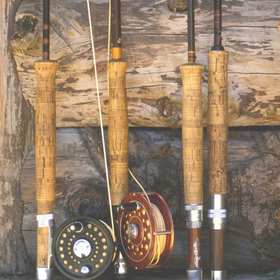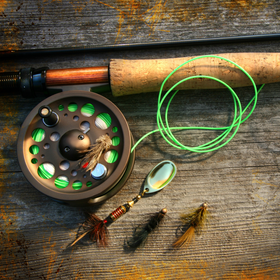Fly fishers like to nickname their prey, and bonefish are no exception. The bonefish is nicknamed the "Gray Ghost”, and if you have ever witnessed these creatures in their Andros Island or Florida Key habitat you know they have earned this nickname. Perfectly camouflaged for their environment these creatures rarely give away their whereabouts easily. Easily for the novice that is, a good guide can seemingly see them in the abstract. And although I am not a huge guide proponent, preferring trial and error, there are times when a guide is a necessity; especially after having spent a nice sum on airfare and lodging. Not to mention the accoutrements required for catching this most worthy of fish.
The bonefish is worthy because of the flat out jaw dropping, blistering runs it can make; stripping off yards of line at mind boggling speed. One great bonefish run can make up for hours of frustration. If you are not used to casting forty yards into a stiff wind, having to make pinpoint accuracy out of these casts, and then knowing where all your line is in relation to your feet, then you are bound to experience some frustration. But it all will peel away like an overripe fruit skin, when you hear your reel sing in the highest pitch imaginable, greedily feeding that running bonefish.
In actuality bonefish do two nice things for the novice fly fisher, or the experienced trout fly fisher getting their salt shoes wet for the first time. One they occasionally do something called ‘tailing’; which means they have their tails upright out of the water, while searching for food; although tails can often be mistaken for mangroves or weeds.
The other ‘nice’ habit they possess is that of creating ‘muds’. Hordes of bonefish school together and create a muddy area to form a protection against sharks or barracudas. Although technically casting into these muds has very little to do with the actual flats fly fishing experience, they do give the first timer a taste of hooking a bonefish. Although these fish tend to be small, 2 pounds or so, an occasional six pounder and up can be hooked this way.
A big bonefish is a double digit one, over ten pounds. And this is ten pounds of very athletic fish indeed. So be prepared, although some anglers prefer a six weight rod, most prefer an eight weight. Also remember you will be required to cast into the wind and distances of at least forty feet. A good guide will help you modify your cast for the wind. There are plenty of bonefish lines on the market, and don’t forget the extra backing needed as well. For this reason a large arbor reel is recommended.
While most Bonefishing is done aboard the deck of a boat, for obvious reasons, you can cover more ground and have the advantage of height. Wading is also done. Sometimes getting away for a quiet few hours of wading, reminds you of the real reason you might be there. Namely natural beauty and solitude. But after awhile wading can also remind you how exhausting it is. For better results take you fishing partner if not a guide, and trade off casting and sighting fish. It is great practice, and very enjoyable when done at a medium pace.
The bonefish is worthy because of the flat out jaw dropping, blistering runs it can make; stripping off yards of line at mind boggling speed. One great bonefish run can make up for hours of frustration. If you are not used to casting forty yards into a stiff wind, having to make pinpoint accuracy out of these casts, and then knowing where all your line is in relation to your feet, then you are bound to experience some frustration. But it all will peel away like an overripe fruit skin, when you hear your reel sing in the highest pitch imaginable, greedily feeding that running bonefish.
In actuality bonefish do two nice things for the novice fly fisher, or the experienced trout fly fisher getting their salt shoes wet for the first time. One they occasionally do something called ‘tailing’; which means they have their tails upright out of the water, while searching for food; although tails can often be mistaken for mangroves or weeds.
The other ‘nice’ habit they possess is that of creating ‘muds’. Hordes of bonefish school together and create a muddy area to form a protection against sharks or barracudas. Although technically casting into these muds has very little to do with the actual flats fly fishing experience, they do give the first timer a taste of hooking a bonefish. Although these fish tend to be small, 2 pounds or so, an occasional six pounder and up can be hooked this way.
A big bonefish is a double digit one, over ten pounds. And this is ten pounds of very athletic fish indeed. So be prepared, although some anglers prefer a six weight rod, most prefer an eight weight. Also remember you will be required to cast into the wind and distances of at least forty feet. A good guide will help you modify your cast for the wind. There are plenty of bonefish lines on the market, and don’t forget the extra backing needed as well. For this reason a large arbor reel is recommended.
While most Bonefishing is done aboard the deck of a boat, for obvious reasons, you can cover more ground and have the advantage of height. Wading is also done. Sometimes getting away for a quiet few hours of wading, reminds you of the real reason you might be there. Namely natural beauty and solitude. But after awhile wading can also remind you how exhausting it is. For better results take you fishing partner if not a guide, and trade off casting and sighting fish. It is great practice, and very enjoyable when done at a medium pace.
Visit our Flies by Species - Bonefish Selection




